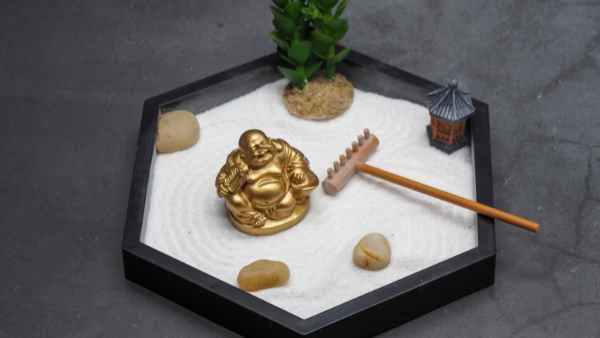Are you a big fan of Zen state of mindset? The Ryoanji Temple garden Japan, has been around for 500 years and is famous for its Zen Garden.
It is also called a Japanese rock garden or dry landscape garden. The main idea is to create a space where you can sit quietly and reflect. These gardens are linked with Zen Buddhism, which focuses on finding peace within yourself.
Picture a serene spot with small rocks and sand where you can make pretty patterns with a rake and maybe a few plants or moss. That’s what a Zen garden is like. It’s a special kind of garden from Japan meant to help you relax and think calmly.
Here’s how you can make your own Zen garden in 5 Simple Steps:
Step 1:
Creating Your Inner Zen Space:

Location, Location, Location: (Think Quiet and Calm)
Look for a quiet spot in your yard or on your patio where you won’t be disturbed and where sunlight can reach.
Less is More: (Embrace the Beauty of Simplicity)
In Zen gardens, having lots of empty space is a good thing. It’s like a clear mind during meditation. In the West, we often feel uncomfortable with emptiness, wanting to fill it up with stuff or noise. But in Zen, emptiness is seen as beautiful, just like the idea of ma (space) and yohaku no bi (the beauty of emptiness).
Size Isn’t Everything, Make it Manageable:
Think about how much space you have and choose a size that you can easily take care of. Even a tiny corner transformed into a Zen garden can make a big difference.

Set the Limits: (Use Natural Materials)
To outline your Zen garden, use things like rocks, pebbles, or wooden borders. In a Zen garden, the space (ma) is seen as a positive thing, and these boundary objects help shape it. They’re really important for the Zen garden’s design.
Step 2:
Gravel and Sand (The Foundation of Serenity)
Building a Peaceful Ground (Choose Wisely)
Select finely crushed gravel, white sand, or a mixture of both to craft a smooth and textured surface for your zen garden. These materials hold special meaning in a zen garden. Gravel symbolizes strength and steadiness, providing a solid base for inner peace. White sand represents purity and calmness, fostering a serene atmosphere.
Crafting Serene Patterns: (Rake with Peace)

Drawing straight lines or patterns in the sand or gravel can be a soothing activity, helping you stay focused and grounded. Different patterns in zen gardens convey unique meanings and evoke varied emotions. Straight lines signify order and simplicity, while circular patterns evoke harmony and unity. Zigzag or wave-like patterns symbolize the flow of energy or water, enhancing the garden’s tranquility and mindfulness.
Symbolic Significance:
The patterns you create through raking can symbolize elements like water (with wavy lines) or gentle ripples (with circular patterns), lending depth to your garden’s ambiance. Zen gardens often feature symbolic designs such as concentric circles, representing interconnectedness, and the yin-yang symbol, portraying balance. Arranging rocks and stones in specific ways can depict mountains, islands, or spiritual beings, inviting contemplation and reflection.
Step 3:
The Power of Rocks:
Making a Peaceful Space: (Choose Your Space Wisely)
Select a few rocks of different sizes and textures to be the focal points of your Zen garden. Odd numbers are considered more aesthetically pleasing in Zen design.

Placement with Purpose (Make Relaxing Designs)

Arrange the rocks asymmetrically, creating a sense of balance and flow. Consider their shapes and sizes, allowing space for contemplation.
It will help you to remain calm and focused. Different shapes in zen gardens mean different things. Straight lines show order and simplicity. Circles show harmony and togetherness. Zigzags or wavy lines show the flow of energy or water, making the garden peaceful.
Symbolism in Stone (Adding Meaning with Symbols)
Large rocks can symbolize mountains, while smaller ones can represent islands or stepping stones.

The shapes you make by raking can mean things like water (with wavy lines) or gentle waves (with circles), making your garden interesting. Zen gardens usually have shapes that mean something, like circles showing connection and the yin-yang symbol showing balance. Putting rocks and stones in special ways can look like mountains, islands, or special things, making you think and feel calm.
Step 4:
Minimalist Greenery (Optional):
Less is More:
Zen gardens usually have more hard stuff than plants. Hard stuff means things in the garden that aren’t alive, like paths, walls, and decks made from strong materials.

But, a few plants can make it even nicer. To keep it simple and peaceful, you might want to put a small bonsai tree or some bamboo in a corner. These plants not only bring nature into the garden but also represent strength, toughness, and simplicity, which are important in Zen.
Choose Plants Wisely:
Opt for small plants that are easy to take care of, like dwarf trees, bonsai, or moss. You can also think about Japanese maple trees, bamboo, and special grasses such as Hakonechloa or Carex. These options add some color and texture to your garden without making it too busy.
Muted Green Leaves:
Pick plants with soft, muted green leaves that go well with the rocks and gravel. These plants create a peaceful background, making your garden a calming place. Some good choices for a simple Zen garden include Japanese sedge grass, dwarf mondo grass, and creeping thyme. They add a bit of green without needing lots of work, perfect for a peaceful Zen garden.
Step 5:
Finishing Touches:
Water Feature (Soothing Sound): (Optional)

Hearing water gently flowing can make you feel calm. Think about getting a small tabletop fountain or a hidden water basin with smooth pebbles.
Put the water feature in a corner of the room. This way, it can make the room feel peaceful without using up a lot of space.
Lighting (Make It Magical): (Optional)
Subtle lighting can create a magical ambiance in the evenings. Use low-lying solar lights or strategically placed spotlights to highlight key features.
Soft lighting can make your garden feel like a special place, especially at night. You can use small solar lights near the ground or carefully placed spotlights to show off important parts of your garden.

Use spotlights to shine on a pretty bonsai tree, a nice sculpture, or a quiet meditation spot. You can make your garden look interesting and calm by lighting up these special areas.
Using Bamboo Curtains: (Natural Divider)

In Japanese zen gardens, they often use bamboo curtains. These curtains act as a gentle, natural divider between the garden and the rest of the world. They also give a feeling of mystery and privacy, making the garden more welcoming to guests.
Seating for Serenity: (Adding Seating for Relaxation)
To fully enjoy your Zen garden’s peaceful vibe, it’s nice to have a simple bench or a small seating area. This gives you a chance to sit down and really soak in the calm atmosphere. You might want to use natural and eco-friendly materials like bamboo or recycled wood for the bench. These materials fit in well with the garden’s natural setting and help create a serene environment that’s good for the planet, too.

To sum up,
Zen isn’t just about sitting quietly and meditating. It includes different activities like gardening, cooking, and arranging flowers, all to help calm the mind and grow spiritually. In today’s busy world, where people are always chasing after material things, it’s important to take time to think about ourselves and reconnect with our inner selves. Masuno talks about the need to build “an abundance of spirit” to balance out the demands of modern life. Zen spaces, like peaceful gardens, give a place for those seeking peace and a connection with nature in the middle of their busy lives. These spaces are more than just nice to look at and help us find inner peace and harmony.

